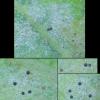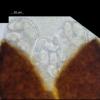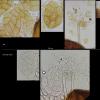
24-12-2025 17:08
Hulda Caroline HolteHello, I have found this propoloid ascomycete on

21-12-2025 09:32
Hello.A tiny ascomycete found embedded in wood in

21-12-2025 21:32
Pol DebaenstHello, Garden, Burgweg 19, Veurne, BelgiumOn 10/1

22-12-2025 23:38
Patrice TANCHAUDBonsoir, récolte sur un mur en pierre, apothéci

22-12-2025 00:47
Patrice TANCHAUDBonsoir, récolte à proximité du milieu dunaire
Erysiphe quercicola on Quercus robur
B Shelbourne,
04-11-2024 22:58
• Several Erysiphe species with similar chasmothecial appendage morphology.
• This seems to be Erysiphe quercicola, chasmothecial appendages no longer than the diameter of the central body, downy patches amphigenous, and leaves not disfigured.
Habitat: Many leaves of Quercus robur with medium to large downy patches, on both sides of leaves, leaves not deformed, some small brown patches (may not be related), with Acer campestre and Crataegus cf. monogyna, around a hedge between a field and road, part of a large area of agricultural land being 'rewilded' (Knepp Estate), Low Weald, southern England, early November.
Chasmothecia: Apparently amphigenous, gregarious, initially yellow, then orangish, finally blackish.
Low magnification (20-40x): Chasmothecia sub-globose to globose, when mature with shortish appendages protruding from the equator, bases uninflated, apices appearing almost capitate due to a ball of dense branching, conidiophores not observed, some whitish lumps on mycelium.




